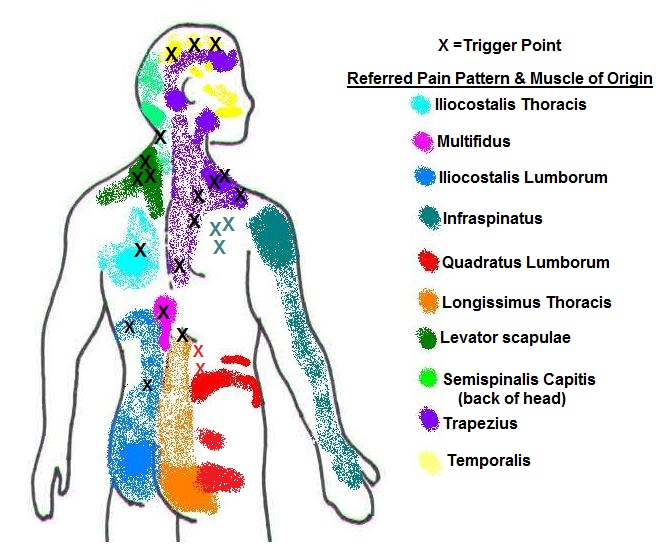Description & Symptoms
A trigger point is essentially a tender “knot” within a taut band of shortened muscle tissue. A common area for trigger points to occur is in the upper trapezius muscle in the top of your shoulder. This trigger point usually causes referred pain to the head and restricted movement of the neck.
Other trigger points can occur elsewhere in the body and often cause pain quite distant from the site of the trigger point. For example, the gluteus minimus muscle around the hip can cause pain all the way down the leg. This can be mistaken for, or co-exist with, “sciatic” pain from trapped nerves in the lower back.

For a comprehensive list of trigger points and their pain referral patterns we recommend www.triggerpoints.net
Causes
Trigger points are usually caused by some sort of stress on the muscle. This may be from a sudden overload in a traumatic injury like a fall, a car accident or lifting something improperly. It may even occur over a long period of time due to prolonged low level tension within the muscle that may be the result of poor posture, degenerative joints or emotional or metabolic stress.
There is on-going research about what’s actually happening physiologically within trigger points. We know that there is a continued release of certain neurotransmitters at the neuromuscular junction. Also, within trigger points, there is continuous low level spontaneous electrical activity, which causes a self-sustaining contraction in that part of the muscle. Even if you consciously try to relax or stretch that part of the muscle, the knot simply won’t relax. Due to this muscle tension there may be some decreased circulation which causes premature fatigue of the muscle at the trigger point, resulting in even more tension.
Treatment
Trigger Point Dry needling (Medical Acupuncture): Needles are inserted into the hyper-irritable bands of muscle with the goal of eliciting a “Twitch Response” that will signify likely deactivation of the trigger point. This also improves blood flow, releasing chronic tension and referred pain from deep muscle bands that would be hard to reach with a hands alone approach. (See our Trigger Point Needling page for more information).
Trigger Point Massage: This involces using short amplitude, slow, deep strokes at 90 degrees to the muscle fibre direction, with little or no oil, in order to achieve maximum fibres contact, sometimes with the aid of massage tools to anchor and strip the muscle fibres even more effectively.
Myofascial Massage: Gliding strokes are used, often with some oil to stretch muscles and their casing (fascia) longitudinally.
At Spine Plus all our osteopaths and physios receive in-house trainning in the above approaches and they often incorporate these techniques into osteopathy / physiotherapy sessions. Alternatively, you can ask to specifically be booked in with them for a dedicated myotherapy treatment. Contact us here.
